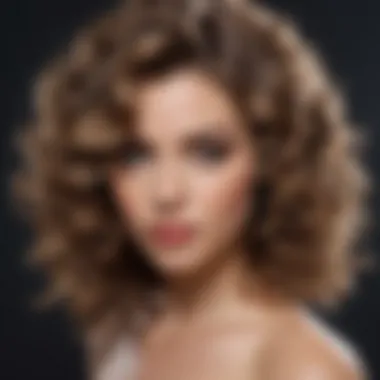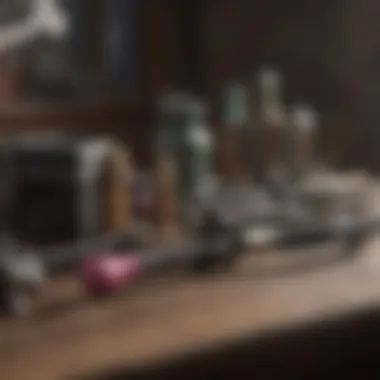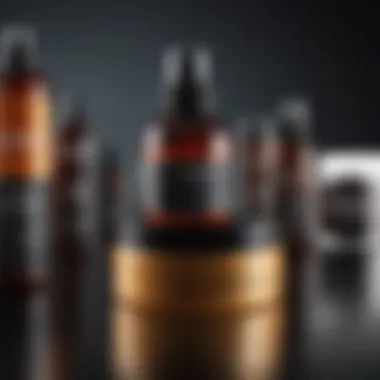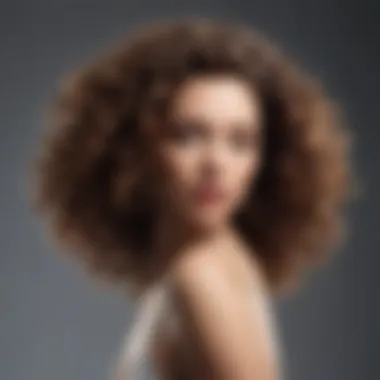Transforming Straight Hair into Beautiful Curls


Intro
The quest for curls is a timeless pursuit in hairstyling. For many, straight hair feels limiting, lacking volume or texture. The allure of curls ranges from soft waves to defined ringlets, offering versatility and elegance. This article will investigate various techniques used to convert straight hair into beautiful curls. We will look into styling methods, products, and the vital role of hair type in achieving the desired look. Understanding these elements is crucial for healthy curling practices.
In many cultures, hair is a significant form of self-expression. Curls can symbolize femininity, creativity, and personality. The science behind hair texture is also intriguing. Straight hair has a different structure compared to curly hair. Curling processes can alter this structure temporarily or even semi-permanently, but it is important to consider the implications for hair health.
Before diving into specific techniques, it’s essential to grasp the basics of hair care and styling. Choices about products and tools can greatly influence the end result, as well as the longevity of curls. By the end of this piece, readers will gain a robust understanding of transforming straight hair into curls while prioritizing health and maintenance.
Preamble to Curling Straight Hair
Curling straight hair is a process that many individuals consider, whether to change their look for a special occasion or simply to enjoy a different style. Understanding the techniques and tools available can help achieve curls that suit one's preferences. It is not just about aesthetics; the right methods can also enhance overall hair health.
Understanding Hair Types
Every individual's hair has unique characteristics that affect how it responds to curling techniques. Hair type can generally be categorized into straight, wavy, curly, and coily. Straight hair tends to lack natural bends and life, which can make curling a challenge. Knowing your hair type is essential as it dictates the methods and products that will be most effective.
Straight Hair often requires different approaches than wavy or curly hair due to its smooth structure. People with straight hair might find it beneficial to use heat-based methods paired with proper products to hold curls better. It's interesting to note that cosmetics have advanced, now providing more options for various hair types, ensuring better outcomes.
On the other side, knowing if your hair is fine or thick also plays a crucial role. Fine hair may need lighter products to avoid weighing down curls, while thicker hair can often withstand heavier formulas. Understanding these nuances leads to better styling decisions.
Common Myths About Hair Curling
In the quest for beautiful curls, many myths often circulate that can mislead individuals. One common misconception is that curls can only be achieved efficiently with heated tools. While heat-based methods are popular and effective, non-heat techniques can also yield impressive results without causing damage to the hair.
Another myth to dispel is the belief that a single technique will work for everyone. Each person's hair reacts differently to various methods, meaning what works for one may not work for another. This emphasizes the importance of experimentation and finding the most suitable approach for your specific hair type.
Key Takeaway: Embracing the differences in hair types and being open to diverse curling techniques can lead to satisfying results.
Lastly, many people think they cannot curl their hair if it has been chemically treated. While there is some truth that processes like straightening can impact curl retention, many techniques can still create beautiful curls, provided care is taken. Continuous learning about your hair and available techniques will empower you to make better styling choices.
The Science of Curls
Understanding the science behind curls is crucial when transforming straight hair. It provides insight into how different curling methods work, the effectiveness of various products, and the impact of heat on hair structure. The process of curling hair involves not just the visible outcome but also the underlying biology of hair itself. By mastering the scientific principles, one can make informed choices regarding techniques and products, ensuring both attractiveness and health for the hair.
Hair Structure and Curl Formation
To grasp how curls form, it is essential to understand hair structure. Hair is made up of a protein called keratin, which is shaped into strands and has three main layers: the cuticle, cortex, and medulla. The cuticle is the outer layer, providing protection. The cortex, located in the middle, is where the texture and curl pattern develop. The shape of the hair follicle determines whether hair is straight, wavy, or curly.
Curly hair tends to have an oval follicle, which makes the strands bend. In contrast, straight hair has a round follicle, creating a smoother appearance. The arrangement of disulfide bonds within the hair shaft also influences curl formation. More disulfide bonds lead to tighter curls. This biological foundation sheds light on why some individuals find styling their hair with curls more achievable than others.
Heat and Its Impact on Hair
Heat plays a major role in the curling process. It alters the hydrogen bonds in the hair, allowing for temporary changes in its shape. When heat is applied through tools like curling irons, it raises the temperature of the hair, enabling it to mold into curls. However, this comes with considerations.
The excessive use of heat can lead to damage. Hair can become dry, brittle, and prone to breakage. Therefore, applying a heat protectant is vital before using styling tools. In addition, it's important to choose the correct heat setting based on hair type. For instance, finer hair requires lower temperatures to avoid damage, while thicker hair can withstand higher heat levels.
To maximize the efficacy of heat styling while ensuring the health of the hair, one should embrace a mindful approach – this includes using the right tools, applying protection, and knowing when to take breaks from heat applications.
By being aware of these scientific principles, individuals can better navigate the curling process, preserving hair quality while achieving delightful results.
Heat-Based Curling Methods


Heat-based curling methods are a cornerstone of hairstyling, offering quick and effective solutions for transforming straight hair into beautiful curls. These techniques leverage temperature to alter the hair's structure, creating waves or spirals that can last for hours or sometimes days. However, it is crucial to approach these methods with care. The primary considerations include the type of heat tool used, the temperature settings, and the duration of heat application, all of which can affect the overall health of the hair.
"Using heat tools correctly can help maintain hair integrity while achieving the desired style."
This section will delve into different heat-based curling tools, their uses, and how to master these techniques for optimal results.
Curling Irons: Choosing the Right Tool
When selecting a curling iron, factors such as barrel size, material, and temperature settings are vital to consider. Barrel size will dictate the tightness of the curl. Smaller barrels create tighter curls, while larger ones form loose waves. There are several materials available:
- Ceramic: Heats evenly and minimizes hot spots, ideal for all hair types.
- Tourmaline: Emits negative ions to reduce frizz and add shine, suitable for thick or coarse hair.
- Titanium: Heats up quickly and is best for fine hair but can be damaging if not used properly.
Furthermore, the temperature control is essential. Heat settings should range between 250°F and 450°F, allowing users to adjust according to their hair type. Fine hair requires lower heat, whereas thicker hair may tolerate higher settings. A curling iron with a programmable temperature is often best for tailoring heat exposure.
Using Hot Rollers Effectively
Hot rollers offer a different approach to heat styling, allowing for curls without the need for hands-on manipulation. To use them effectively, first ensure that hair is clean and slightly damp. This helps with better curl retention. Follow these steps:
- Section Hair: Divide hair into manageable sections for even styling.
- Preheat Rollers: Turn on the rollers and allow them to heat up completely.
- Roll Hair: Starting from the ends, roll hair towards the scalp, securing it in place.
- Cool Down: Leave them in until they cool completely, which helps set the curl.
This method not only provides volume but also reduces direct heat contact with the hair, which can be gentler in comparison to other heat tools.
Technique for Heat Styling
To achieve the best results with heat styling, employing correct techniques is of utmost importance. Here are some fundamental techniques:
- Hold the Curling Iron Vertically or Horizontally: This affects the curl shape. Vertical placement gives a spiraled look, while horizontal rolls create more relaxed waves.
- Use a Protective Spray: Before applying heat, always use a heat protectant spray. This adds a barrier against potentials damage.
- Timing Matters: Avoid leaving sections on the heat tool for too long. Typically, 5 to 10 seconds should suffice. For optimal curls, practice makes perfect.
By understanding and implementing these techniques, one can create curls that not only look good but are also done with care for the hair's health.
Non-Heat Curling Techniques
Non-heat curling techniques are essential to explore for those seeking to achieve beautiful curls without causing damage to their hair. Often, the allure of heat styling can overshadow the benefits of these methods. Non-heat techniques not only preserve the integrity of hair but also promote healthier styling practices. Furthermore, many of these techniques require minimal tools, making them accessible and easy to implement at home.
These methods are particularly beneficial for individuals with fine or damaged hair, as they reduce the risk of further harm that may arise from excessive heat. Importantly, many non-heat techniques can also be used in conjunction with other hairstyling methods to enhance the longevity and appearance of curls. Understanding non-heat curling techniques equips users with the knowledge to create versatile looks, providing an alternative avenue for hairstyling creativity.
Braiding: A Timeless Method
Braiding hair is a simple yet effective way to create curls without heat. This technique has been used for centuries, proving its effectiveness across generations. To start, simply divide hair into sections and braid each section tightly. The number of braids you create will influence the size of the curls; smaller braids yield tighter curls, while larger braids create looser waves.
Steps for Braiding Curls:
- Begin with damp hair to help set the curls.
- Divide your hair into sections.
- Braid each section securely.
- Allow braids to remain for several hours or overnight.
- Carefully unravel the braids and gently tousle the curls.
Braiding not only produces beautiful curls but also adds texture and volume. It’s important to note that this method works best on slightly damp hair to ensure that the curls last longer.
Twist and Pin Curls
Twist and pin curls are a versatile non-heat technique that allows for a variety of curl styles. This method involves twisting sections of hair and securing them to the scalp with pins or clips. The tightness of the twist directly correlates with the final curl's shape.
Technique Overview:
- Start with slightly damp hair for the best results.
- Take a small section of hair and twist it tightly.
- Wrap the twisted hair around itself to create a small bun.
- Secure it with a bobby pin or clip.
- Repeat the process for the entire head.
- Leave the curls in for several hours or overnight for maximum hold.


This method not only provides curls but also keeps hair out of the way while styling. Twist and pin curls are particularly effective for achieving vintage hairstyles or a modern textured look.
Headband and Sock Curls
Headband curls and sock curls are clever, no-heat methods that yield incredible results. Both techniques utilize common household items to transform hair into beautiful curls.
Headband Curling Steps:
- Start with damp hair and place a stretchy headband over your head like a crown.
- Take small sections of hair and wrap them around the headband,
- Continue until all hair is wrapped.
- Leave the headband in for several hours or overnight.
- Carefully unwrap the curls and style as desired.
Sock Curling Steps:
- Take a soft, clean sock and cut off the toe section to create a tube.
- Roll the sock into a donut shape.
- Place the sock on the ends of a section of damp hair and roll the hair around it tightly.
- Leave it in overnight for best results.
- Unroll the sock and reveal soft curls.
Each of these methods boasts the advantage of hands-free styling while sleeping or going about daily tasks. They allow for a comfortable experience without the stress of managing heat styling products.
Non-heat techniques provide an excellent way to embrace curls without compromising hair health while allowing for creative styling options.
The Role of Products in Curling Hair
The use of products is a critical element in the process of curling straight hair. They serve multiple purposes, from protecting the hair to ensuring that the curls last longer. When transforming your hair, product choice can greatly impact the final outcome. Specific products can enhance the texture, provide hold, and even improve the health of your hair in the long run. Understanding which products to choose and how to use them is essential for achieving the desired results.
Heat Protectants: Why They Matter
Heat protectants are essential when using any method that involves heat, such as curling irons or hot rollers. They work as a barrier between the hair and heat sources. The high temperatures can cause damage, leading to dryness and brittleness. Using a heat protectant creates a shield that minimizes this risk. Look for heat protectants that contain silicones, as they provide a smooth layer that can withstand moderate heat.
Key Benefits:
- Prevents Damage: Protects the hair from the high temperatures.
- Enhances Shine: Many heat protectants also add a glossy finish to the hair.
- Improves Manageability: Makes hair easier to style and maintains elasticity.
To apply, spray or apply a small amount evenly on dry hair before styling. Make sure to cover all sections for maximum protection.
Mousses and Styling Creams
Mousses and styling creams are excellent for providing hold and texture to curls. Mousses are lightweight products that can add volume without weighing the hair down. They often contain polymers that help shape and maintain curls throughout the day. Styling creams offer a different texture; they typically provide moisture and better define curls.
Why You Should Use Them:
- Volume Boost: Mousses can create fuller, bouncier curls.
- Curl Definition: Creams help define and separate curls for a polished look.
- Frizz Control: Many formulas include ingredients that combat frizz and promote shine.
Apply mousse or cream evenly through damp hair, scrunching the curls as you go. This helps set the style while keeping it fresh and lively.
Hairsprays: Finishing Touches
Hairspray is often the final product used to secure and maintain curls. There are different types of hairspray, each varying in hold strength. Light hold sprays can provide a more natural, flexible finish, while firm hold options can keep curls intact for an entire day or more. When choosing a hairspray, consider factors such as humidity and your hair's texture.
Essential Considerations:
- Hold Strength: Choose according to your needs; for long-lasting styles, opt for firm hold.
- Humidity Resistance: Look for sprays that are resistant to humidity if you live in a humid area.
- Easy to Brush Out: A good hairspray should allow you to brush through your hair without feeling stiff.
To use, hold the can about 8 to 10 inches from your hair and apply evenly to finished curls in a sweeping motion. This ensures a light and invisible finish without build-up.
Products play a pivotal role in maintaining the integrity and the look of curled hair. Proper usage can lead to healthier hair and more defined curls.


Caring for Curled Hair
Caring for curls is essential for maintaining their shape and health. It's easy to think that once you achieve that perfect curl, your work is done. However, curls need ongoing attention and specific care to stay looking their best. This section will cover washing and conditioning strategies, detangling and frizz control, and nighttime care—all pivotal for maintaining the integrity and beauty of curled hair.
Washing and Conditioning Strategies
Washing curled hair requires a different approach compared to straight hair. Curls tend to be drier because natural oils do not travel down the hair shaft as easily. Here are some strategies:
- Use sulfate-free shampoos: Sulfates can strip hair of its natural oils, leading to dryness. Opting for sulfate-free options can help maintain moisture levels.
- Condition consistently: Regular conditioning is crucial. Use a rich conditioner that nourishes the curls and enhances their formation.
- Co-washing: This method involves using conditioner to wash hair instead of shampoo. It helps keep curls hydrated and minimizes frizz.
- Frequency: Aim to wash your curls less frequently. Over-washing can lead to loss of moisture, making the hair brittle.
Implementing these strategies can vastly improve the look and feel of your curls, preparing them for styling and ensuring their longevity.
Detangling and Frizz Control
Detangling curly hair can be a delicate task. Curls are prone to tangling and frizz due to their natural texture. To avoid damage, consider the following:
- Use a wide-toothed comb: When your hair is damp, use a wide-toothed comb to gently detangle. Start from the tips and work your way up to prevent breakage.
- Detangle with conditioner: Applying a leave-in conditioner can make the process smoother. It provides slip and reduces friction.
- Frizz control products: Look for products containing anti-frizz ingredients like argan oil or silicones. These can help smooth the hair’s surface and keep frizz at bay.
- Avoid friction: Use a microfiber towel or an old t-shirt to dry your hair. Traditional towels can create friction, leading to frizz and breakage.
By focusing on these detangling strategies, you can manage curls more efficiently while minimizing potential damage.
Nighttime Care for Curls
The way you care for curls during the night can significantly impact their appearance in the morning. Effective nighttime practices can help preserve curls and minimize tangling:
- Pineapple method: Gather hair loosely at the top of your head in a "pineapple" shape. This keeps curls intact overnight, reducing squishing and flattening.
- Use a silk or satin pillowcase: These materials create less friction than cotton, helping to maintain curl integrity and reduce frizz.
- Hair wraps: Consider using a silk scarf or a hair wrap to protect curls while you sleep. This can keep them from tangling and breakage.
- Moisturize before bed: A light leave-in conditioner or curl cream can provide added hydration overnight, ensuring your curls remain soft and bouncy.
Frequently Asked Questions
Understanding common questions regarding curling techniques is crucial for individuals seeking to transform straight hair into curls. The Frequently Asked Questions section can provide clarity and guide readers through the diverse options available. It addresses practical concerns and misconceptions, ensuring individuals make informed decisions about curling their hair.
How Long Do Curls Last?
The duration of curls depends on several factors, including hair type, curling method used, and environmental conditions. Generally, curls created with heat can last longer, especially when combined with suitable products. For example, using a curling iron or hot rollers may yield results that can last throughout the day or even up to a few days. However, humidity can affect longevity; in humid conditions, curls may become looser quicker.
There are anecdotal accounts indicating that curls might last longer on thicker hair due to its weight and structure. For individuals with fine hair, using a strong hold hairspray or styling cream can enhance longevity. It is also wise to consider proper aftercare; avoiding excessive brushing and unnecessary washing will help maintain the shape of the curls.
Can You Curl Hair Without Heat?
Yes, curling hair without heat is entirely possible and benefits both hair health and styling versatility. Techniques such as braiding, twist-and-pin curls, and using headbands can effectively shape straight hair into curls without the risk associated with heat damage.
Methods include:
- Braiding: Simple yet effective for producing waves or curls. The tighter the braid, the more defined the curls will be.
- Twist and Pin Curls: This method involves twisting sections of hair and pinning them in place. The longer the hair is pinned, the more defined the curls will become.
- Headband Curls: By wrapping hair around a headband overnight, you can achieve beautiful curls by morning without heat.
While these methods may take more time than heat styling, they offer a healthier option with results that can be surprisingly effective. Individuals often appreciate that these techniques not only transform their look but also contribute to the overall condition of their hair.
Curling without heat is a sustainable choice that promotes hair health without sacrificing style.
Closure
The conclusion of this article encapsulates the diverse methods explored for transforming straight hair into curls, emphasizing their significance. Understanding how to curl hair effectively is not only about aesthetics; it also involves knowledge of one's hair type and the techniques that work best with it.
One of the main benefits of mastering curling techniques is the versatility they bring to hairstyling. Curls can dramatically change an appearance and provide a different texture, adding volume and movement to otherwise straight hair. Furthermore, the careful consideration of health is crucial. Using appropriate products, such as heat protectants, helps ensure that hair remains strong and vibrant after applying heat. Non-heat methods also offer safe alternatives, catering to individuals who wish to minimize damage.
Moreover, the maintenance of curls is equally important. Proper washing, conditioning, and care strategies help keep curls looking their best. Knowledge of detangling methods and nighttime routines contribute to longevity, demonstrating that curling hair is an ongoing process rather than a one-time event.
As we have seen, successful curls result from a combination of technique, appropriate products, and aftercare. By synthesizing these elements, one can achieve beautifully curled hair while maintaining its health. Investing time into learning and practicing these strategies not only enhances one's hairstyling repertoire but also promotes confidence in personal presentation.
"Understanding your hair and the techniques that suit it best allows for beautiful results without sacrificing hair health."



